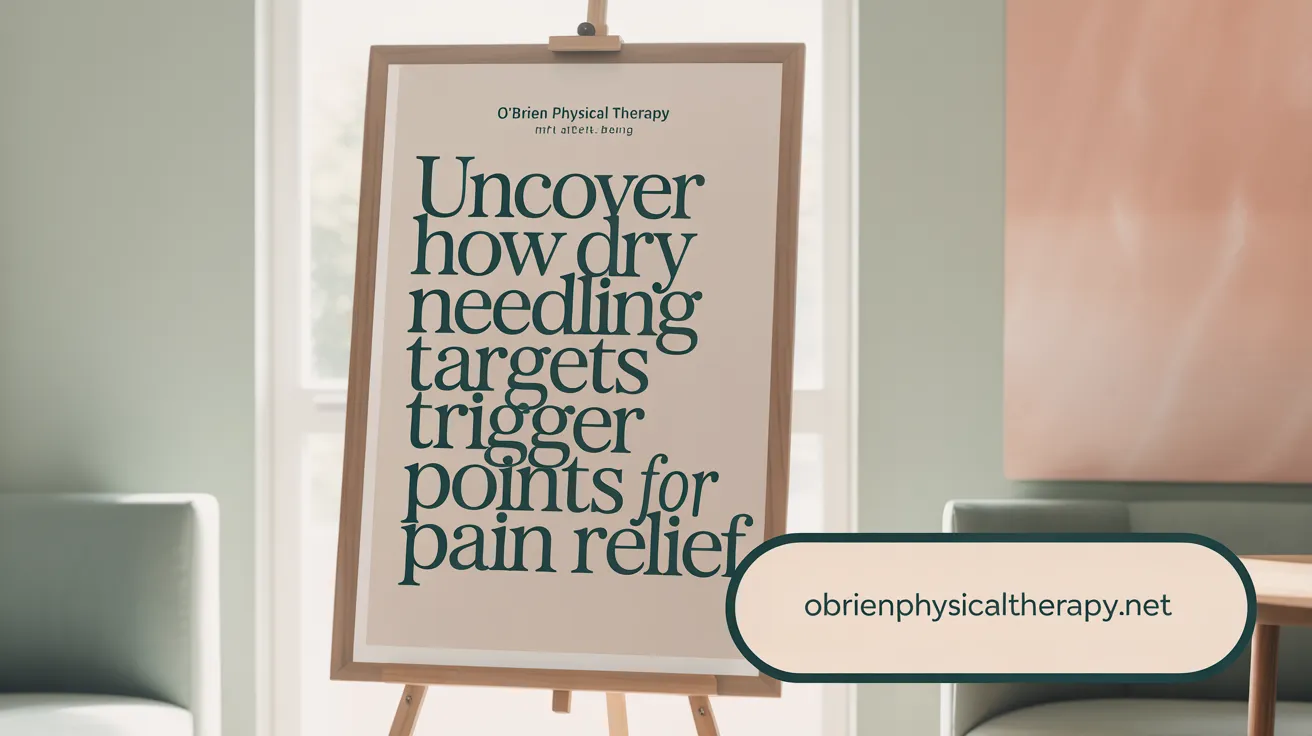Understanding Dry Needling: A Modern Therapeutic Approach
Dry needling has emerged as a transformative technique within physical therapy for alleviating musculoskeletal pain and enhancing movement. Unlike traditional acupuncture, dry needling is grounded in Western medical principles and specifically targets myofascial trigger points—tight, tender knots within muscles that restrict motion and cause pain. This article explores the science behind dry needling, its clinical benefits, procedures, safety, and how it fits into contemporary physical therapy practices to improve patient outcomes.
What is Dry Needling and How Does It Work?
 Dry needling is a modern physical therapy technique used to treat pain and movement impairments related to myofascial trigger points. These trigger points are hyperirritable, tight areas within muscles that can cause localized pain and refer pain to other parts of the body. The procedure involves inserting very thin, sterile, solid needles into or near these trigger points, which often stimulates muscle contractions called twitch responses.
Dry needling is a modern physical therapy technique used to treat pain and movement impairments related to myofascial trigger points. These trigger points are hyperirritable, tight areas within muscles that can cause localized pain and refer pain to other parts of the body. The procedure involves inserting very thin, sterile, solid needles into or near these trigger points, which often stimulates muscle contractions called twitch responses.
The goal of dry needling is to deactivate these trigger points, leading to muscle relaxation, decreased pain, and improved range of motion. This is achieved through mechanisms such as eliciting local twitch responses that help release muscle tension. It also promotes increased blood flow to the affected area, aiding in tissue repair and reducing inflammation.
Unlike acupuncture, which is based on Eastern energy flow theories, dry needling is rooted in Western medicine. It targets specific musculoskeletal issues by directly addressing dysfunctional muscle tissue, thereby accelerating recovery and improving function.
The process works by creating microlesions in the tissue that signal the body to send healing cells to the area. Additionally, dry needling can trigger neurophysiological responses that lessen pain sensitivity and activate pain-relief pathways, often leading to immediate relief. When performed by trained healthcare providers using sterile, disposable needles, dry needling is generally safe and effective for many musculoskeletal conditions, including headaches, tendonitis, back pain, and joint issues.
Clinical Benefits of Dry Needling in Physical Therapy

What are the benefits of dry needling, such as pain relief and improved mobility?
Dry needling provides multiple physiological and functional advantages. It is particularly effective in reducing pain by targeting myofascial trigger points — sensitive, knotted areas within muscles that trigger localized or referred pain. When these trigger points are stimulated with fine needles, they can cause the muscle to relax, which alleviates discomfort and pain.
In addition to pain relief, dry needling enhances movement and flexibility. By decreasing muscle tightness and releasing tension, it increases the range of motion, allowing patients to regain their normal activity levels more quickly. The release of tension also improves blood flow to affected tissues, promoting faster healing and reducing inflammation.
Patients often experience immediate or rapid improvements following treatment, with many reporting reduced pain and increased mobility within hours or days. This rapid response makes dry needling an attractive complementary approach, especially when combined with exercises or manual therapy.
Furthermore, dry needling stimulates the body’s natural healing mechanisms through creating microtrauma—tiny injuries in muscle tissue—which triggers increased circulation, tissue repair, and the release of endorphins, the body's natural painkillers. This process supports overall recovery and can help manage chronic pain conditions. Learn more about how dry needling releases pain and aids healing.
When performed by trained practitioners, dry needling is safe and minimally invasive, with low risk of complications. Its ability to alleviate pain, reduce muscle tension, and promote healing makes it a versatile and effective technique in physical therapy for managing a broad spectrum of musculoskeletal issues.
Indications and Conditions Treated with Dry Needling

What conditions and indications are typically treated with dry needling in physical therapy?
Dry needling is primarily used to address myofascial pain caused by trigger points—small, hyperirritable areas within muscles that can trigger pain and tightness. These trigger points can develop due to injury, overuse, poor posture, or repetitive movements.
Common musculoskeletal conditions that benefit from dry needling include muscle strains, tendinopathies like tendinitis, neck and back pain, headaches, migraines, shoulder impingements, knee pain, and joint stiffness. The technique helps to alleviate pain, relax overactive muscles, improve blood flow, and enhance movement restrictions related to these conditions.
In injury rehabilitation, dry needling is effective for soft tissue injuries such as ligament sprains, muscle strains, and post-surgical recovery. It also supports chronic pain management and helps restore muscle function.
Trigger points are central to many pain syndromes; by targeting these stubborn knots, dry needling can produce immediate or gradual relief.
Overall, conditions involving muscle dysfunction, restricted motion, and pain stemming from trigger points are the primary indications for dry needling. When integrated into a comprehensive therapy plan, it can accelerate healing, reduce discomfort, and improve overall movement.
Dry Needling Versus Acupuncture: Clarifying Differences

How does dry needling compare to acupuncture?
Dry needling (DN) and acupuncture are both techniques involving the insertion of thin needles into the body, yet they originate from different medical traditions and serve different purposes. For more details, see Dry Needling vs Acupuncture.
Comparative principles and origins
Dry needling is rooted in Western medical practice. It targets myofascial trigger points—knotted, tender areas within muscles—to relieve pain, reduce muscle tension, and improve movement. It is performed by trained healthcare providers such as physical therapists, chiropractors, or physicians who focus on musculoskeletal conditions.
Acupuncture, on the other hand, has been practiced for thousands of years in traditional Chinese medicine. It involves inserting needles along meridian lines to balance the body's energy, or Qi, and promote overall health and well-being. Acupuncture aims to treat a wide range of health issues, including systemic conditions and mental health. For a comparison, see Differences Between Dry Needling and Acupuncture.
Treatment goals and targeted tissues
Dry needling primarily focuses on releasing muscle knots and improving neuromuscular function by eliciting local twitch responses in trigger points. Its goal is immediate pain relief and restoring normal muscle function.
Acupuncture seeks to influence the body’s energy flow and can target various systems, including immune function, hormonal balance, and emotional health. Its points are chosen based on traditional maps and diagnostic methods. Learn more at What Is Dry Needling?.
Differences in practice and philosophy
Practitioners of dry needling base their technique on modern scientific research. They evaluate pain patterns and muscular dysfunction before inserting needles into specific trigger points. It is a more direct, mechanical approach. For a comprehensive overview, see Dry Needling Therapy Technique.
Conversely, acupuncture involves a holistic philosophy, often considering the person’s overall health, constitution, and energy balance. Its practice includes gentle needling, moxibustion, and other modalities.
Patient considerations and treatment selection
Patients should consider their condition, preferences, and the practitioner’s expertise. Dry needling is generally suitable for musculoskeletal pain and movement impairments and is supported by evidence-based protocols. It offers rapid relief for conditions like muscle strains, headaches, and joint pains. More information about its clinical applications is available at Benefits of Dry Needling.
Acupuncture might be preferred for systemic issues, mental health, or in cases where balancing energy and overall wellness are desired. It may require more sessions for systemic health improvements.
Always consult with licensed and trained professionals to determine the most appropriate approach based on individual needs.
Safety, Techniques, and Evidence Supporting Dry Needling

What procedures and techniques are involved in dry needling therapy?
Dry needling therapy involves a detailed assessment to locate myofascial trigger points within muscles, followed by the insertion of fine, sterile needles directly into or near these points. The aim is to produce a local twitch response, which helps release muscle tension. Techniques vary from superficial insertions, reaching up to 10mm into the subcutaneous tissue, to deeper injections that penetrate into the muscle tissue itself. Practitioners often utilize additional methods like electrical stimulation to enhance therapeutic effects. The procedure typically lasts from a few seconds to around 20 minutes, depending on the targeted area. During treatment, the practitioner may perform multiple insertions tailored to the patient’s specific condition, sometimes combining dry needling with other therapies such as manual manipulation or exercises. Proper technique and anatomical knowledge are fundamental to ensure safety and effectiveness when performing dry needling.
What are the safety considerations, risks, and side effects?
Dry needling is generally considered a safe procedure when performed by trained and licensed healthcare providers. Common minor side effects include soreness, bruising, and slight bleeding; bruising occurs in about 7.7% of cases, and soreness may be experienced by roughly 16% of patients. These effects are usually temporary and resolve within a few days. Serious risks are rare but can include infections, nerve injuries, bleeding, or a pneumothorax when needles are used near the lungs. Such complications have an incidence rate of less than 0.1% (Safety of dry needling). Proper training, sterile needle use, and careful anatomical navigation significantly minimize these risks. Patients with certain conditions—like infections, bleeding disorders, pregnancy, or compromised immune systems—should consult their healthcare provider before undergoing dry needling. Overall, adherence to safety protocols ensures that dry needling remains a low-risk option for effective pain management.
What does the current evidence-based research say about the clinical effectiveness of dry needling?
Research indicates that dry needling can effectively reduce pain and improve function, especially in conditions like neck pain, shoulder disorders, tendinopathies, and fibromyalgia. Systematic reviews and meta-analyses have demonstrated that patients often experience immediate or short-term relief post-treatment. Mechanistically, dry needling appears to influence the neuromusculoskeletal system by disrupting dysfunctional muscle bands, decreasing inflammatory mediators, and modulating central nervous system pathways — which collectively promote tissue healing and pain alleviation (How dry needling works). While the evidence supports its short-term benefits, long-term outcomes are less conclusive, with some studies suggesting sustained improvements up to a year, while others call for further high-quality research. Overall, current findings affirm dry needling as a valuable adjunct in clinical practice, particularly when integrated into comprehensive rehabilitation programs.
How can patients and practitioners be educated about the benefits and applications of dry needling?
Effective education involves providing clear, evidence-based information about how dry needling works, its benefits, and safety considerations. Patients should receive detailed explanations of what to expect during and after treatment, including potential temporary soreness or bruising. Practitioners can enhance their skills through specialized training, workshops, and certification programs accredited by professional organizations such as the American Physical Therapy Association. Continuing education ensures safe, effective practice and updates on the latest research. Educational resources like brochures, online articles, and professional webinars can help both patients and clinicians understand appropriate indications, limitations, and the importance of individualized treatment plans. Promoting open communication and informed consent further supports safe and effective use of dry needling therapy.
Integrating Dry Needling into Physical Therapy for Enhanced Patient Care
Dry needling stands as a scientifically grounded, effective modality within physical therapy that addresses muscular pain and dysfunction with precision and minimal invasiveness. By targeting myofascial trigger points, it offers rapid pain relief, improved mobility, and accelerated healing, complementing other therapeutic interventions. While differences from acupuncture clarify its unique clinical approach, evidence supports dry needling’s role in musculoskeletal pain management and rehabilitation. Safety remains paramount, and with appropriate practitioner training, risks are minimal. As ongoing research continues to refine its applications and efficacy, dry needling is poised to remain an integral tool in modern physical therapy, benefiting patients seeking natural, targeted relief from muscular pain and dysfunction.
